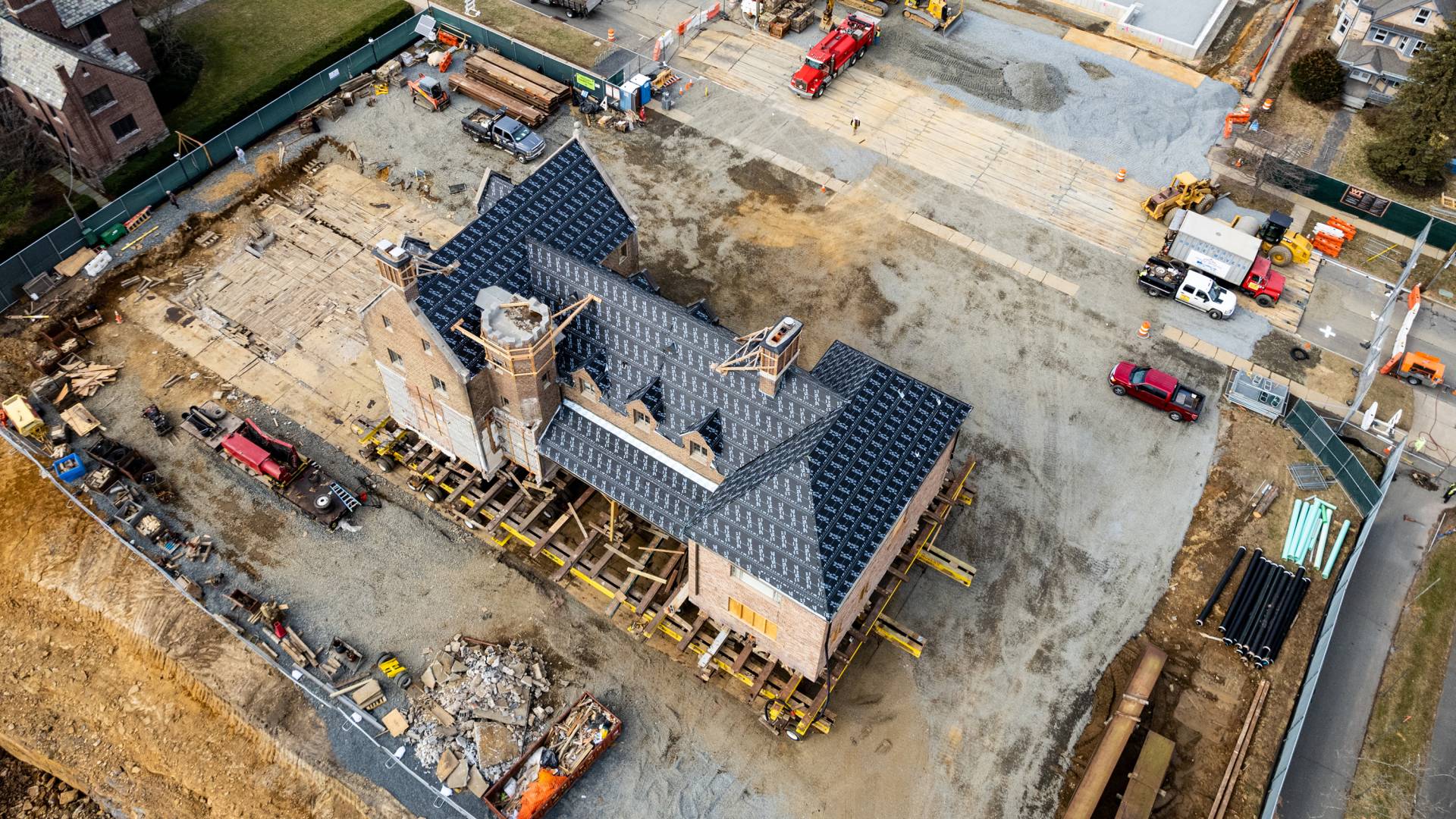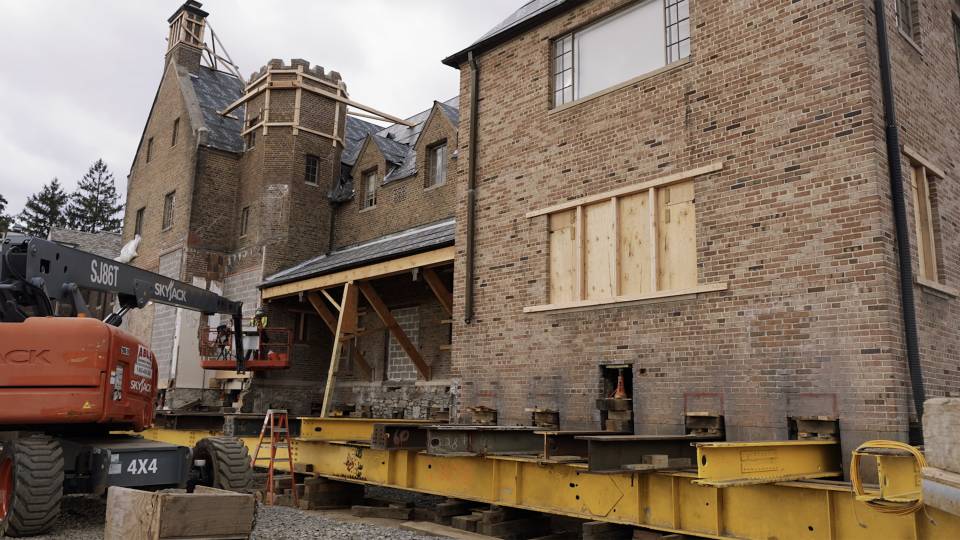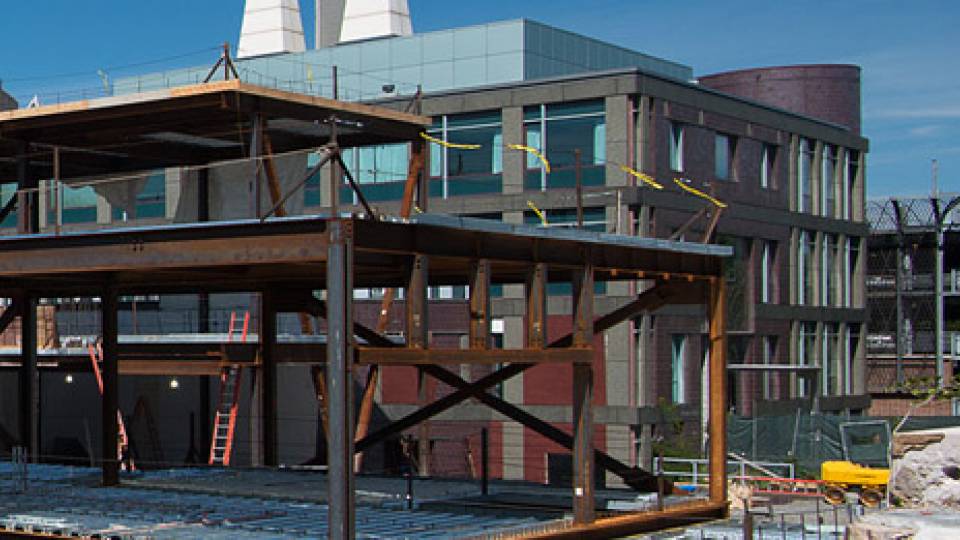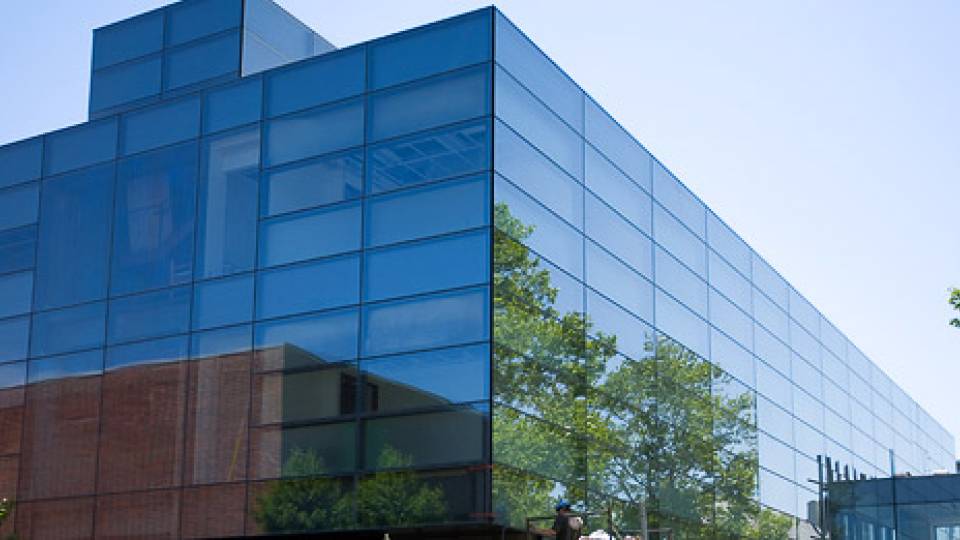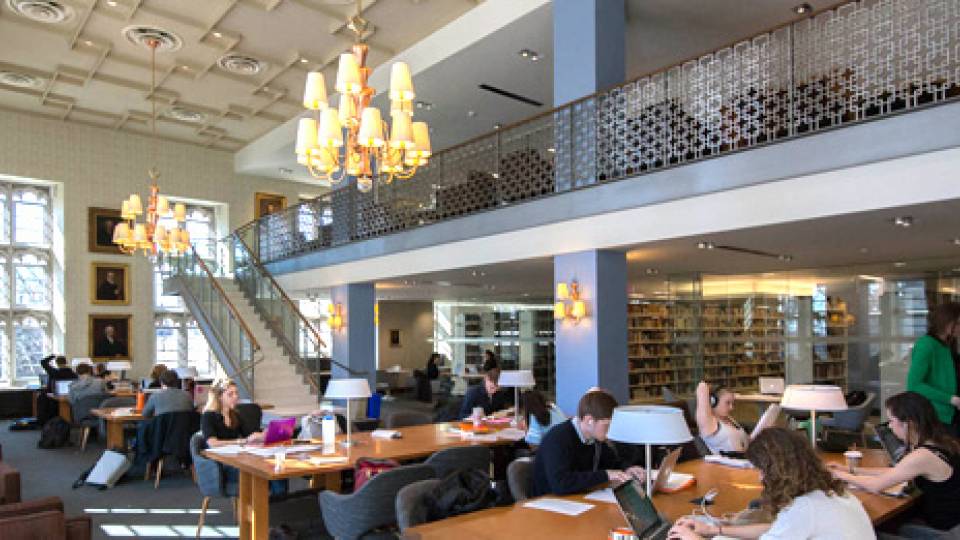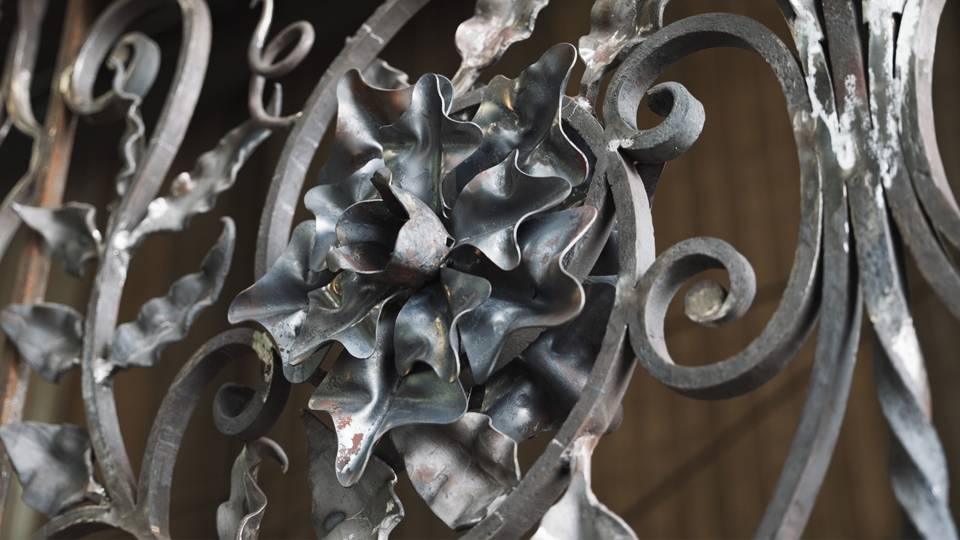An aerial view of the move site shows the former Court Club shifted away from its original foundation. The new foundation at 110 Prospect can be seen at the top of the photo. Workers built a haul road between the two locations to provide the building with a more even surface for its journey.
After 96 years, the historic brick Tudor Revival building that once stood at 91 Prospect Ave. has a new address — 110 Prospect.
Princeton University completed moving the former Court Club, one of the University’s eating clubs, on Friday, Feb. 17, after months of meticulous preparation and eight days after first rolling the building away from its original foundation.
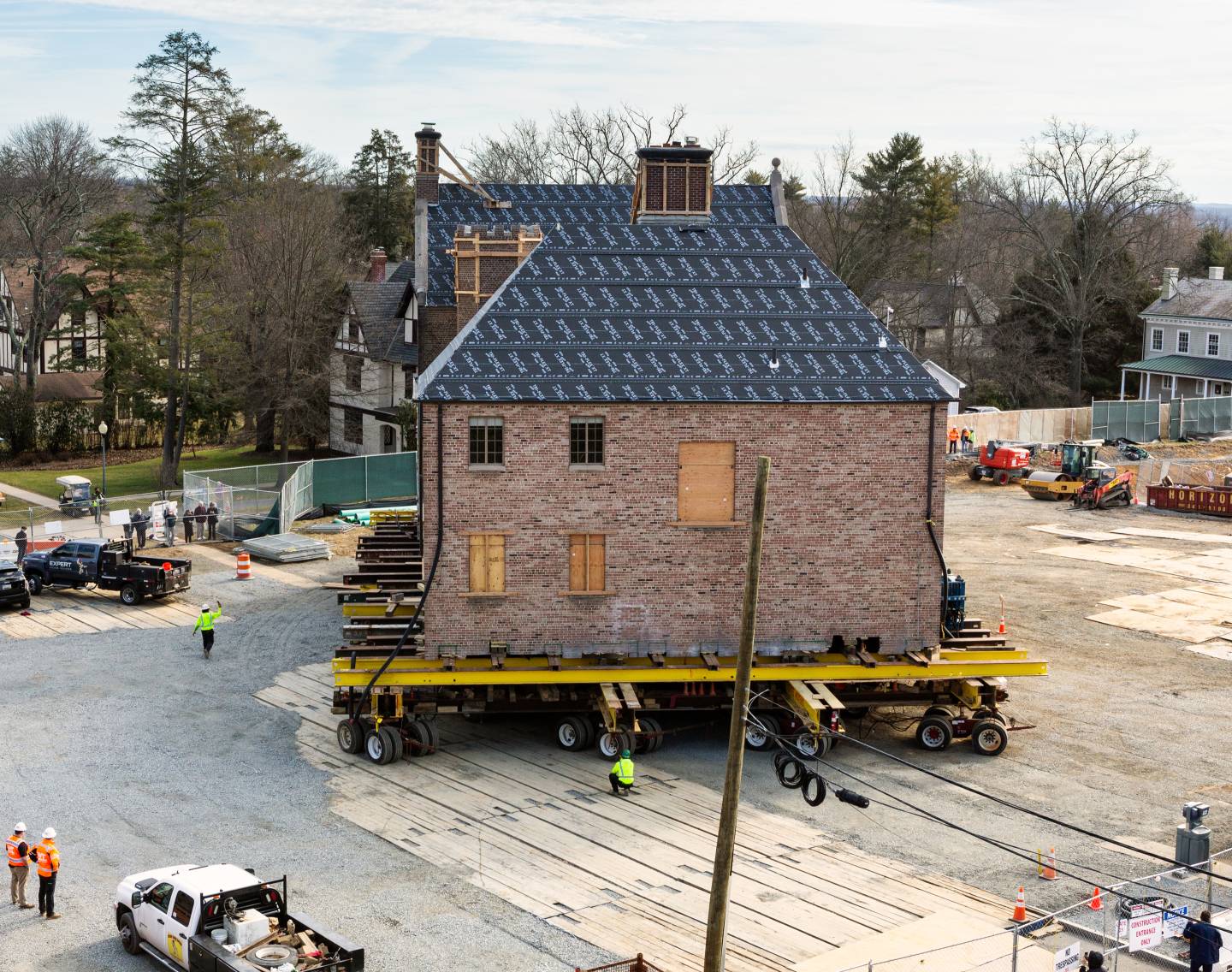
After being moved away from its foundation, the building was rotated 180 degrees by positioning the dolly wheels in a semicircle and turning around a pivot point.
The sight of the massive structure — lifted about eight feet into the air and set atop a framework of steel beams and 30 hydraulic wheel dollies — drew a crowd of onlookers each day starting when the move began Feb. 9. Some stood for hours watching from either side of a closed section of Prospect Avenue, and also from every level of the Prospect Avenue Garage. Their ranks included faculty, staff, students, neighbors, alumni and curiosity-seekers from throughout the area.
Tendrils of ivy remained clinging to the walls of 91 Prospect as it began its move. During each stage, members of the moving company team crawled beneath the rigging and between the dollies, weaving in and out, making constant adjustments to the wheel positions and ensuring that the building was kept level by hydraulic lifts.
“It’s amazing,” said Charles Fefferman, the Herbert E. Jones, Jr. ’43 University Professor of Mathematics, a graduate alumnus and a Fields Medal recipient, who made at least four visits to the site to watch the move with his wife, Julie. “How many times do you see something like this? I was aware that other houses have moved [at Princeton], but this was of a different order.”
A handful of watchers who remained through dropping temperatures, rain and wind late in the afternoon on Feb. 17 were rewarded with seeing the move to its finish. They let up a cheer from the garage terraces as the structure was carefully aligned over the far edge of its new foundation on the even-numbered side of Prospect Avenue. A couple of passing cars honked their horns in celebration.
“It is relatively uncommon to move a building, but there are some examples such as Alexander Hamilton’s home and the Cape Hatteras Lighthouse,” said University Architect Ron McCoy. “It has a level of excitement, and it symbolizes an important moment for Princeton.”
The University has moved a number of buildings throughout the years — notably Corwin Hall in 1963 and Joseph Henry House, which was moved twice in the late 19th and early 20th centuries — as part of its stewardship of its history. On Prospect Avenue, which the Princeton Council designated a historic district in 2022, no fewer than seven buildings have been moved on and off the street by the eating clubs over the years.
Moving and restoring 91 Prospect allowed the University to maintain the character of Prospect Avenue, which is home to the eating clubs and other landmark structures, including the recently restored Ferris Thompson Gateway.
The building served for 36 years as the Court Club, which expanded the original structure in the mid-1950s, adding its left wing. The Court Club ceased operations in 1964, and in 1968, the building became part of Stevenson Hall, a dining and social alternative to the eating clubs, together with the former Key and Seal building next door at 83 Prospect Ave.
Among the alumni who chose to forgo the eating club bicker process and join Stevenson Hall for dining were former first lady Michelle Obama, Class of 1985.
In recent years, 91 Prospect has been home to Princeton’s Office of the Dean for Research. In 2021, the Princeton Planning Board approved a plan to rotate the building 180 degrees and relocate it on the opposite side of the street as Princeton University prepares to build a new campus for Environmental Studies and the School of Engineering and Applied Science.
As part of its planning board approval with the town, the University also agreed to conserve 114 and 116 Prospect Ave., and to move and renovate the Queen Anne Victorian that previously stood at 110 Prospect. Both moves were overseen by the University’s construction manager, Whiting-Turner, and performed by Expert House Movers of Sharptown, Maryland.
The move of the wood-frame Victorian was completed in November 2022. Relocating 91 Prospect, however, was a more complicated and delicate operation.
Princeton Mayor Mark Freda called the move “a very impressive accomplishment” and was among those who came to view 91 Prospect as it was in transit, along with the municipal engineer and assistant engineer.
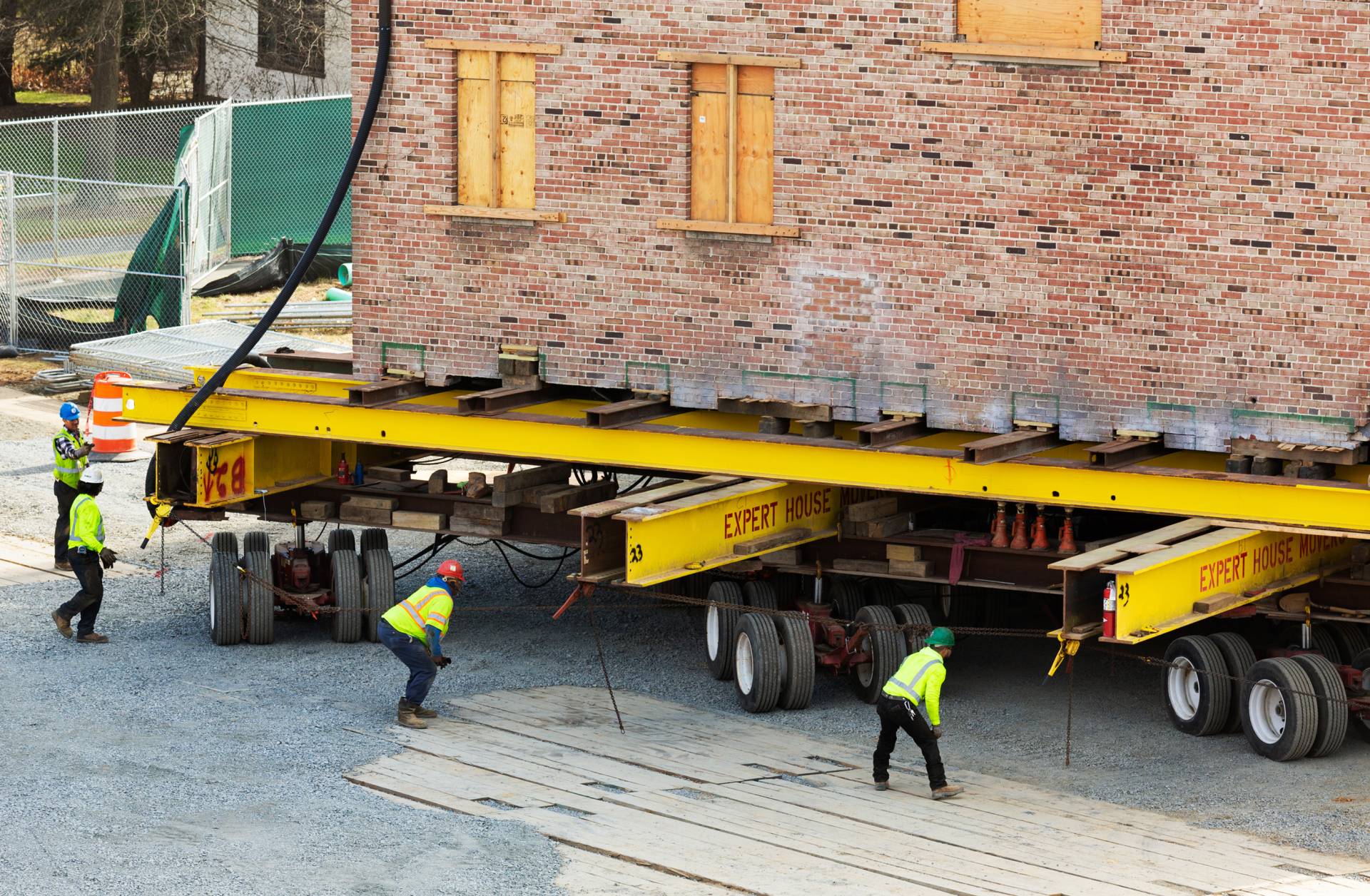
Workers from Expert House Movers of Sharptown, Maryland, kept close watch on the dollies and hydraulic lifts to ensure the building was delivered precisely over its new site and that the stress load on the building was minimized throughout the process.
“The engineering and the specialized equipment needed to lift the building, move it to a new location and then put it on a new foundation is amazing,” Freda said. “And the fact that Princeton University listened to the community and decided to save the three buildings that are the other side of Prospect Street as part of this project shows how town and gown can work together.”
He added, “As the University grows, it is reassuring to see that finding a way to blend their projects into the town is important to them.”
It takes a village to move a building
More than a year ago, shortly after the relocation of 91 Prospect was approved, municipal officials stood at the site with the University’s construction manager and members of the project team. “We knew at that moment this was no small feat, and that it would ‘take a village’ to make this happen,” said Mark Kinn-Gurzo, senior project manager for the Office of Capital Projects.
Numerous University offices were involved in the planning, including facilities, general counsel, risk management, community and regional affairs, and parking and transportation. The cooperation of the municipality and local utilities were also needed for the many logistical hurdles on the ground, including the month-long closure of a segment of Prospect Avenue and the removal and relocation of overhead wires.
Kinn-Gurzo said the University’s neighbors on Prospect Avenue “were amazing and very patient during this process,” adding “the municipality was a true partner in this effort, and I’m so thankful for that.”
The preparations to the building itself were extensive. The slate roof was removed to lighten the weight of the building. The first-floor windows were removed, as well, along with a kitchen addition and back patio.
To improve the building’s rigidity, the front doorway and other openings, many with limestone trim, were shored up with cinder blocks and mortar. The two chimneys and overhangs were braced, and extra shoring was completed beneath the roof and across the center of the building to hold together the two wings.
To lift the building from its foundation, 60-foot steel beams were inserted beneath the structure vertically, and 120-foot beams were inserted below those horizontally. Additional vertical beams were used to attach the rigging to the hydraulic wheel dollies.
With the steel supports in place, the weight being moved was almost 1,000 tons — the equivalent of 40 fully loaded garbage trucks. A “haul road” also was installed across Prospect Avenue to ensure the building could travel over a level surface.
“This is a large project on the scale of the things that we do,” said Gabriel Matyiko, vice president of Expert House Movers. “It’s not the biggest move we’ve done, but it’s definitely one of the biggest jobs we’ll do in 2023.”
The hardest part of the job wasn’t getting the building up on steel and moving on wheels, Matyiko said. Rather, it was the logistics of working on an active street with a large-scale construction project just behind the site.
“Also, the fact that we had to move another building to make way for this building,” he said. “Consequently, the site we are moving to is very, very tight, and that can’t be understated.”
Ready to roll
Across the street at 110 Prospect, the base of a new concrete foundation was poured in advance. Wood cribbing was set atop the concrete and overlaid with steel beams topped with steel plates ready to receive the wheels of the dollies.
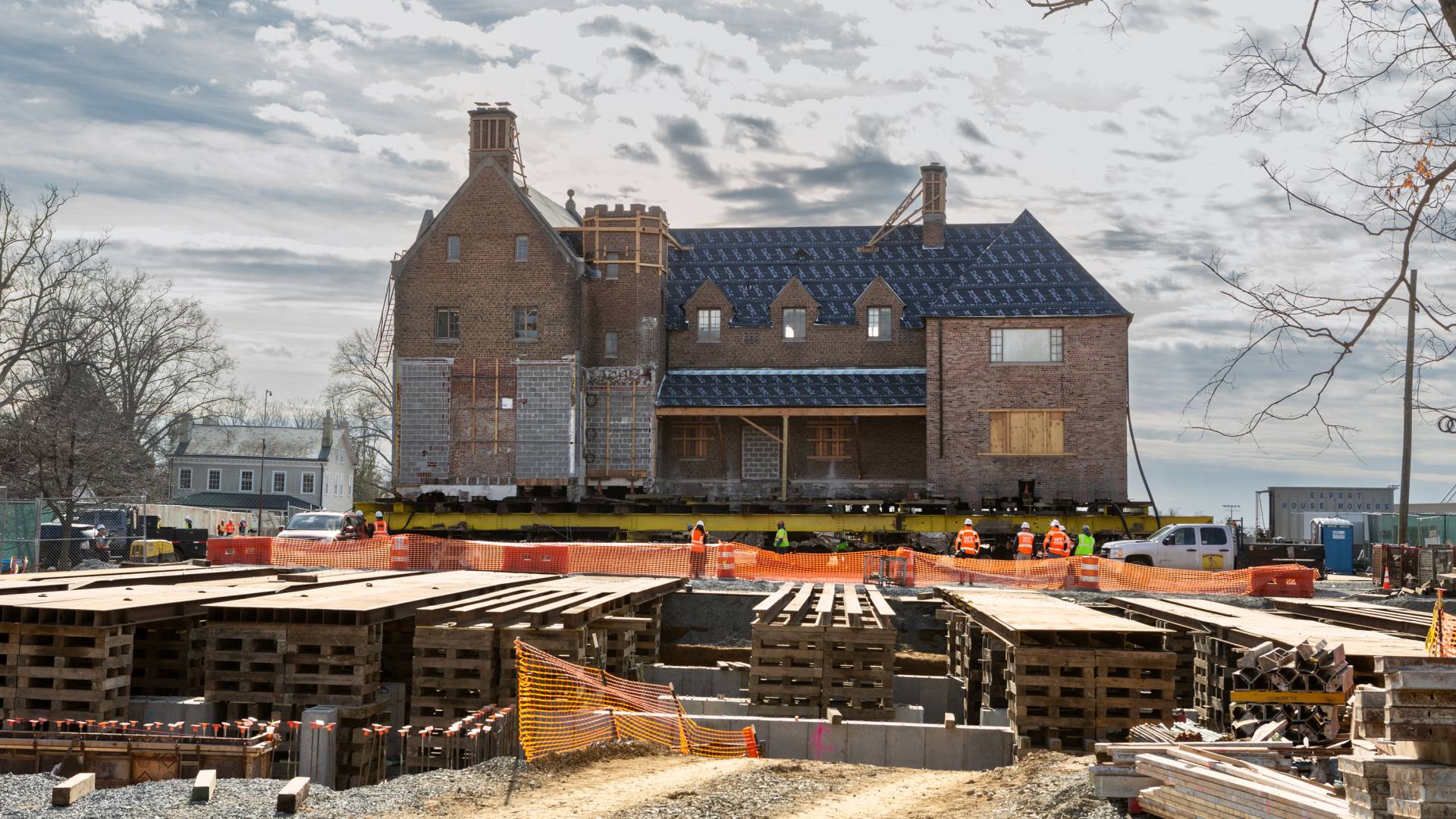
After months of careful preparation, the historic building at 91 Prospect Ave. was moved to make way for a new campus for Environmental Studies and the School of Engineering and Applied Science.
The building’s initial move, on Feb. 9, was just to the left of its original foundation. The 180-degree rotation began on Feb. 15. The building was rolled into the middle of Prospect Avenue on Feb. 16 and made its final approach to its new foundation on Feb. 17.
Carolyn Havens Niemann, Class of 1989, and her husband, Michael Niemann, Class of 1990, traveled from Montclair, New Jersey, on Valentine’s Day to view the move and commemorate their relationship which began inside 91 Prospect while she was president of Stevenson Hall. He served as social chair the following year.
“It was where our love affair started,” she said. “We figured the building is moving, we have to see this.”
Niemann said it was strange to see the building shifted away from 83 Prospect — also a former eating club with a similar brick facade with limestone trim — given their shared history. “It was eerie,” she said. “I am thrilled that the University has saved the building, even though it will be odd to see it on the other side of the street.”
Over the next several weeks, the dollies will be removed, the concrete foundation will be completed underneath, then the steel beams removed, and the building lowered and secured. Prospect Avenue is expected to fully reopen to pedestrians and traffic by March 6.
The new 110 Prospect, which will continue to serve as the home of Princeton’s Office of the Dean for Research, will be renovated to include new office and conference spaces, as well as a larger veranda in the back. It also will be made fully accessible.
Pablo Debenedetti, dean for research and the Class of 1950 Professor in Engineering and Applied Science and professor of chemical and biological engineering, said he and his staff are excited for their return to the historic building.
“The neighborhood is beautiful, it’s peaceful, it’s quiet and very green,” he told The Daily Princetonian’s podcast in a recent episode. “It is very conducive for the work of the mind.”
The now-vacated site of 91 Prospect will become the location of a new front lawn and pavilion providing space for faculty offices and research as part of a larger facility for chemical and biological engineering and continuing into a “necklace” of connected buildings expanding the University’s facilities for engineering and environmental science. The project will enable breakthrough teaching and research in service of humanity while enhancing the public experience of Prospect Avenue.
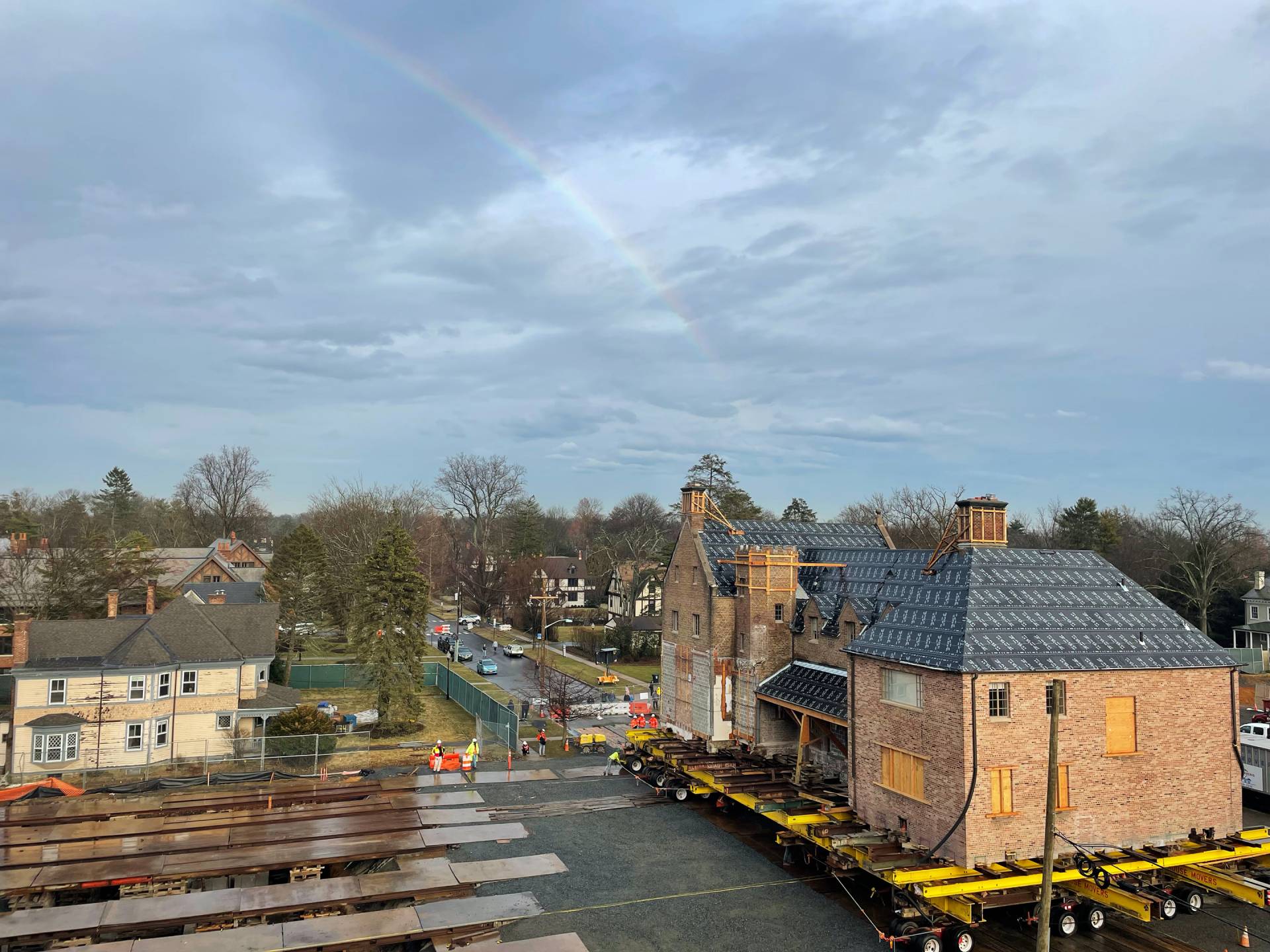
Weather varied throughout the eight days of the move from mild and sunny to rainy and cold. A rainbow following steady rain on the next-to-last day seemed a fortuitous sign for the future.
